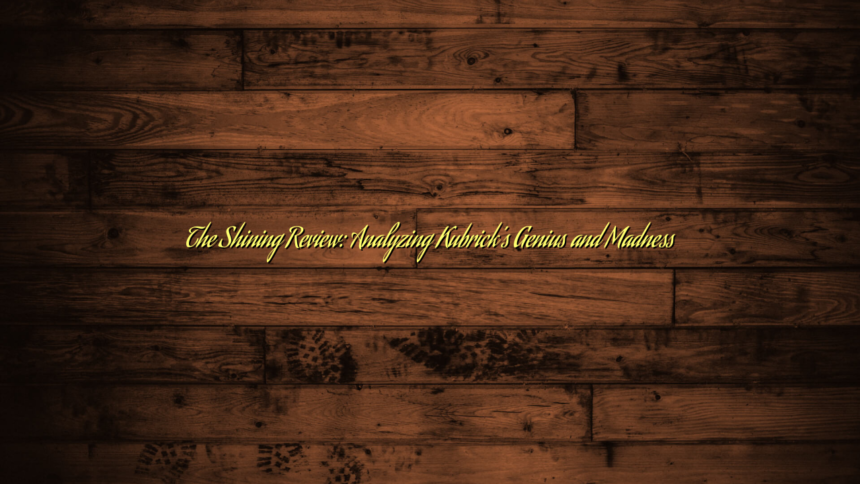The Shining Review
The Shining Review, Stanley Kubrick’s The Shining stays one of the vital dissected items of cinema so far. Based mostly on Stephen King’s novel of the identical identify, Kubrick’s adaptation has sparked numerous discussions about its themes, visible storytelling, and psychological horror. On this complete The Shining overview, we are going to discover the intricacies of the movie, inspecting Kubrick’s distinctive cinematic methods and the underlying insanity that permeates the narrative.
The Legacy of The Shining
Launched in 1980, The Shining has transcended its horror style roots, changing into a cornerstone of recent cinema. The movie tells the story of Jack Torrance, performed by Jack Nicholson, who turns into the winter caretaker of the remoted Overlook Resort. As the cruel winter units in, Jack’s psychological state deteriorates, resulting in terrifying penalties. The movie’s haunting imagery, highly effective performances, and unsettling ambiance have established it as a must-watch basic for cinephiles and informal viewers alike. This The Shining overview will delve into why the movie continues to captivate audiences almost half a century after its launch.
A Visible Masterpiece: The Cinematic Strategies of Kubrick
One of the hanging options of The Shining is its visible composition. Kubrick employed modern methods which have made an enduring impression on the movie trade.
Compelling Use of Shade and Symmetry
From the very starting, Kubrick’s use of coloration serves to represent psychological states. The intense reds, eerie greens, and stark whites create a way of unease, whereas symmetrical framing enhances the general disorientation. The long-lasting blood pouring from the elevators and the colourful carpet patterns within the Overlook Resort symbolize each psychological entrapment and the thoughts’s chaotic rigidity.
The Iconic Steadicam Photographs
Kubrick was one of many early adopters of the Steadicam, which permits for extremely clean, fluid digicam motion. In The Shining, this method is exquisitely showcased within the scenes of Danny Torrance using his tricycle by means of the lodge’s labyrinthine corridors. These pictures immerse the viewers within the character’s perspective, reflecting his innocence and the refined, creeping dread that surrounds him.
Cautious Consideration to Particulars
Kubrick’s meticulous nature extends past digicam work; he painstakingly crafted each side of The Shining. The puzzles, the symbolism within the décor, and even the positioning of furnishings all serve to construct a world brimming with rigidity and hidden meanings. Every body is layered with complexity, making the movie a wealthy topic for evaluation and dialogue, a side captured completely on this The Shining overview.
Themes of Isolation and Insanity
At its core, The Shining is a psychological exploration of insanity and the results of isolation. Kubrick masterfully depicts the breakdown of the thoughts and the fragility of sanity by means of the narrative.
The Isolation of the Overlook Resort
The Overlook Resort acts as a personality in its personal proper, an immense and domineering presence that slowly drives Jack to insanity. The sense of isolation is palpable all through the movie, emphasizing not solely Jack’s bodily confinement but additionally his emotional detachment from his household. This setting amplifies the psychological themes, making the viewers really feel the depth of Jack’s despair as he succumbs to the lodge’s sinister affect.
The Deterioration of Jack Torrance
Jack Torrance’s descent into insanity is a chilling exploration of psychological sickness. On the movie’s outset, he’s a struggling author in search of redemption. As he interacts with the lodge and its haunting visions, his character modifications dramatically. Jack’s slowly unraveling psyche and his violent outbursts make for a compelling and horrifying character examine. Nicholson’s efficiency captures the complexity of Jack’s duality—his outer allure and internal chaos—a theme that resonates all through this The Shining overview.
The Function of Household Dynamics
Household is one other essential theme inside The Shining. Kubrick explores the delicate relationships withn the Torrance household, in the end resulting in horror.
Wendy and Danny: The Innocence of Childhood
Wendy Torrance, portrayed by Shelley Duvall, embodies maternal resilience and vulnerability. Her relationship together with her son, Danny, showcases a protecting bond amidst chaos. Danny’s psychic means, “the shining,” serves as a metaphor for innocence beneath menace. Wendy’s fierce dedication to guard Danny as Jack spirals into insanity speaks volumes concerning the instinctual nature of motherhood—a poignant side of the movie successfully highlighted on this The Shining overview.
The Poisonous Masculinity of Jack Torrance
Jack’s character represents poisonous masculinity, the place aspiration and ambition devolve into aggression and violence. His wrestle for management and dominance over his household reveals profound societal points, making The Shining related past its horror components. The movie critiques male entitlement and the destructiveness of unchecked ambition, offering a layered interpretation worthy of research.
The Enduring Affect of The Shining
Over the many years, Kubrick’s The Shining has influenced not solely filmmakers but additionally artists throughout disciplines.
Cult Following and In style Tradition
The movie’s quotes, imagery, and motifs have seeped into well-liked tradition, from references in tv reveals to parodies in different movies. Line like “Here is Johnny!” has cemented Jack’s character as a cultural icon. The impression of The Shining extends past its preliminary screening, because it continues to encourage homage and evaluation, evident in documentaries like Room 237.
Legacy of Psychological Horror
Kubrick’s method to psychological horror units a precedent for future movies. Administrators have paid homage to his methods, striving to copy the unnerving sense of dread and character examine discovered all through the movie. The slow-building rigidity, mistrust amongst characters, and haunting atmospheres can hint their lineage again to Kubrick’s masterwork.
Conclusion: Actionable Insights
In conclusion, Stanley Kubrick’s The Shining is greater than only a horror movie; it’s a advanced tapestry exploring themes of insanity, isolation, and familial dynamics. This The Shining overview has delved into the movie’s creative deserves, character evaluation, and its lasting affect on cinema and tradition. For these trying to perceive cinema’s psychological dimensions, The Shining is a necessary textual content.
For Your Subsequent Viewing:
- Watch with Intention: Take note of the main points, colours, and digicam angles. Think about how they affect the general temper.
- Focus on with Pals: Sharing insights can improve understanding and unearth completely different interpretations.
- Rewind and Replay: Many scenes are layered with which means. Watching once more can convey new insights and understanding.
Whether or not you are a seasoned cinephile or a newcomer to the horror style, The Shining provides a wealth of fabric to discover. Dive in and discover out why this masterpiece continues to hang-out and provoke thought throughout generations.




